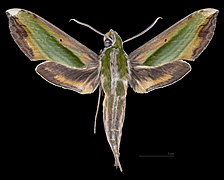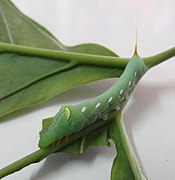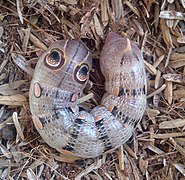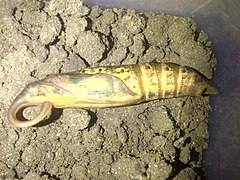Pergesa
| Green pergesa hawkmoth | |
|---|---|
 | |
| Scientific classification | |
| Kingdom: | Animalia |
| Phylum: | Arthropoda |
| Class: | Insecta |
| Order: | Lepidoptera |
| Family: | Sphingidae |
| Subfamily: | Macroglossinae |
| Genus: | Pergesa Walker, 1856 |
| Species: | P. acteus |
| Binomial name | |
| Pergesa acteus (Cramer, 1779)[1] | |
| Synonyms | |
| |
Pergesa is a monotypic moth genus in the family Sphingidae first described by Francis Walker in 1856. Its only species, Pergesa acteus, the green pergesa hawkmoth, was described by Pieter Cramer in 1779.[2]
Distribution
It is found in Sri Lanka, India, Nepal, Myanmar, Thailand, eastern and southern China, Taiwan, Japan (the Ryukyu Archipelago), Peninsular Malaysia, Indonesia (Sumatra, Java, Sulawesi) and the Philippines.
Description
The wingspan is 64–80 mm. Head, thorax and abdomen are purplish grey, which differs from Theretra nessus. Vertex of head and a dorso-lateral stripe to thorax and abdomen is green. Forewings are purplish grey with a green oblique central area from below apex to inner margin with some indistinct lines on it. There is an irregular dark outer area with some yellow inside it. Hindwings with anal patch and submarginal band are pointed.[3]
Larvae are greenish with a dark dorsal line, and a subdorsal pale line on thoracic somites. The fourth somite has a large ocellus, which is white ringed with brown and centered with blue and green.[4] The ocelli on the fifth to tenth somites are bluish with yellow centers. Lateral area is greenish and horn is yellowish. The caterpillars feed on Alocasia odora, Syngonium podophyllum, Amorphophallus, Arisaema, Caladium, Colocasia, Dieffenbachia, Begonia, Commelina, Leea, Cissus and Vitis species.[5]
-
 Male dorsal
Male dorsal -
 Male △ ventral
Male △ ventral -
 Female dorsal
Female dorsal -
 Female △ ventral
Female △ ventral
-
 Eggs
Eggs -
 Caterpillar
Caterpillar -
 Caterpillar
Caterpillar -
 Caterpillar with extended eyespot
Caterpillar with extended eyespot -
 Caterpillar with eyespots in their resting state
Caterpillar with eyespots in their resting state -
 Front view with the head and the thoracic segments retracted into the body.
Front view with the head and the thoracic segments retracted into the body. -
 Dorsal view of Pergesa acteus caterpillar.
Dorsal view of Pergesa acteus caterpillar. -
 Pergesa acteus caterpillar from one side
Pergesa acteus caterpillar from one side -
 Pupa
Pupa -
 Imago side
Imago side
References

- ^ "CATE Creating a Taxonomic eScience - Sphingidae". Cate-sphingidae.org. Retrieved 2011-10-26.[permanent dead link]
- ^ Savela, Markku. "Pergesa Walker, 1856". Lepidoptera and Some Other Life Forms. Retrieved November 24, 2018.
- ^ Hampson, G. F. (1892). The Fauna of British India, Including Ceylon and Burma: Moths Volume I. Taylor and Francis – via Biodiversity Heritage Library.
- ^ Leong, T. M. & D'Rozario, V. "Larval Development and Metamorphosis of the Hawkmoth, Pergesa acteus (Cramer) in Singapore (Lepidoptera: Sphingidae: Macroglossinae)" (PDF). National University of Singapore. Archived from the original (PDF) on 3 October 2016. Retrieved 6 July 2016.
- ^ Pittaway, A. R.; Kitching, I. J. (2018). "Pergesa acteus (Cramer, 1779) -- Green pergesa hawkmoth". Sphingidae of the Eastern Palaearctic. Retrieved December 16, 2018.
- v
- t
- e
























